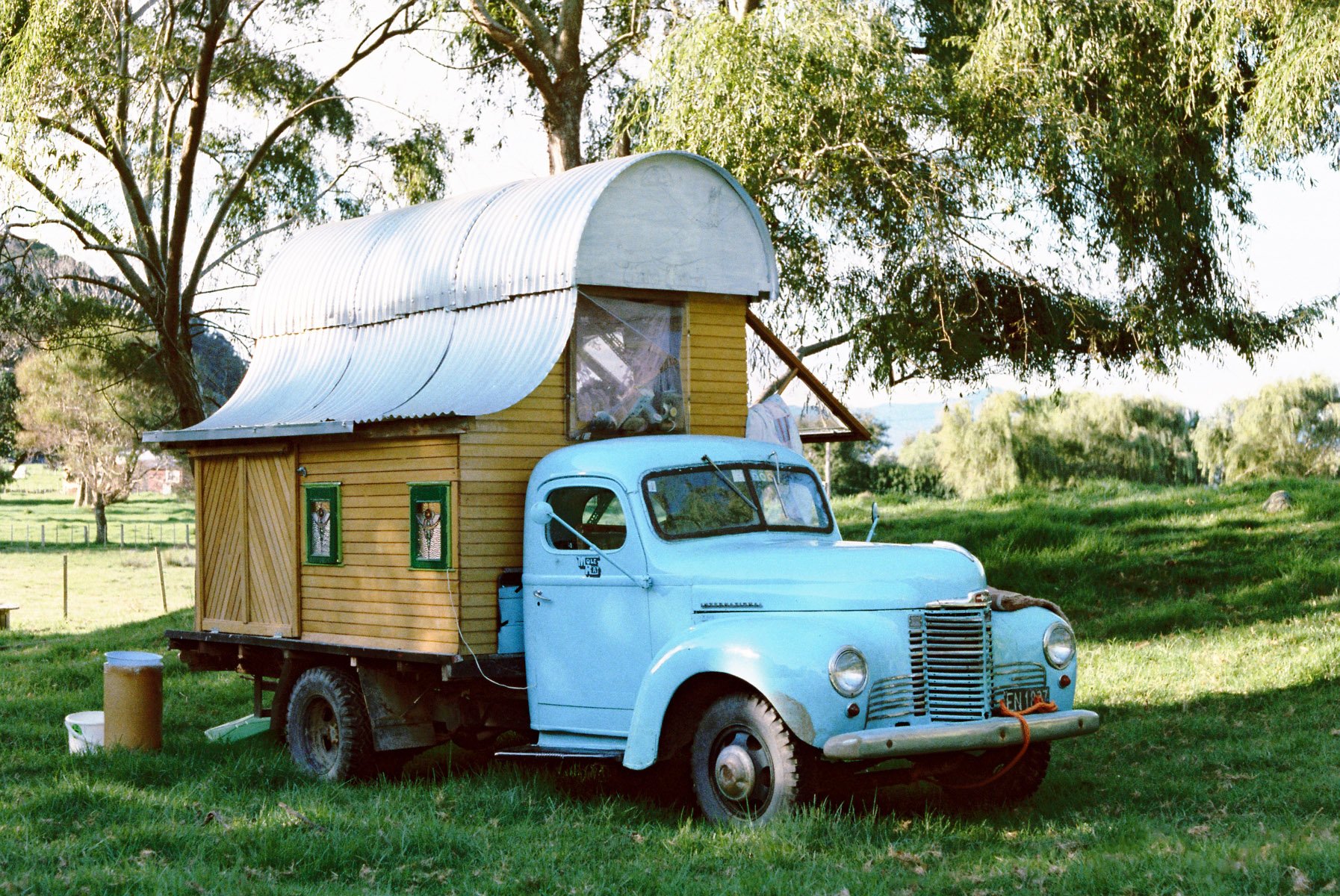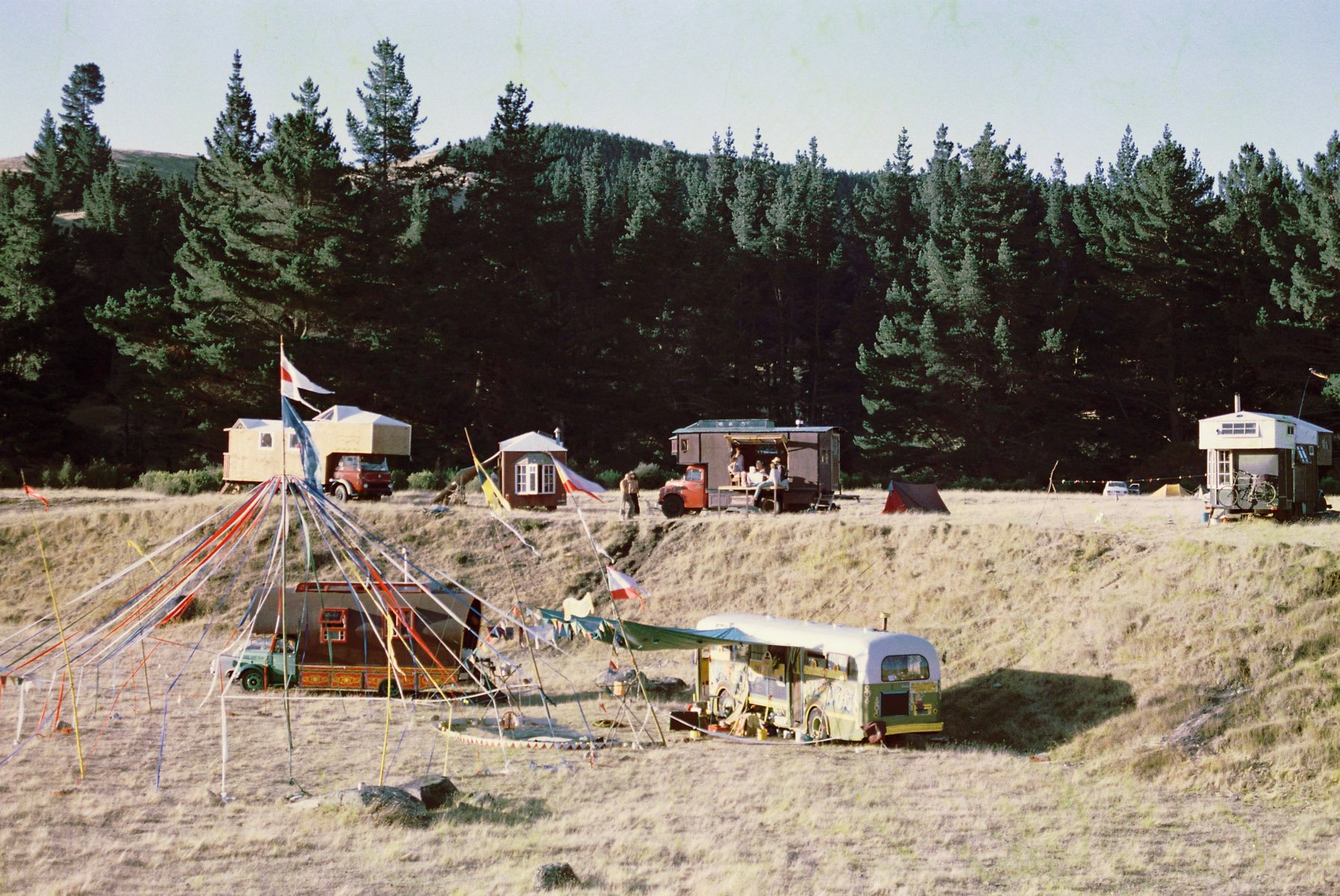Road People of Aotearoa - House truck journeys 1978-1984
Road People of Aotearoa - House truck journeys 1978-1984
Photographs by Paul C Gilbert
Foreword by Michael Colonna
Essays by Haru Sameshima and John B Turner
Published by Rim Books, Auckland, 2021
Hardback, 184 pages
275 x 235 mm, 200 illustrations
ISBN 978-0-9951184-6-1
Essay by Tony Watkins for PhotoForum, courtesy of Rim Books
We are all nomads. We move through life. We arrive only to move on. We explore. We discover. We grow old. We decay. Along the way we weave a rich and complex tapestry of relationships and connections. Through these we establish a sense of place. We belong. Nomads belong in ways that those hiding behind security fences cannot understand.
Life is a journey. Everyone who is truly alive is a road person. Death is just the unfortunate conclusion. The nomad who fails to return.
The rituals of the Pacific are the rituals of journey. The arrival. The welcome and hospitality. The poroporaki. The naming of place, leaving behind a story.
Every Medieval cathedral and all Islamic architecture left one stone unworked to make it clear that each building was not finished. The option for growth, change and discovery always remained. Living architecture is in a constant state of becoming. Road architecture is alive. A Council’s certificate of completion is really a death certificate. Today life support keeps people going long after they have died.
Sadly almost all today’s architecture seeks to make certain the uncertainties of a dynamic world.
We huddle inside, imprisoned by insulation, afraid of the natural world that gives us life. There is a conundrum here. The cost of our award-winning, static, lifeless architecture is a dramatic increase in both environmental uncertainty and emissions. More than anything else the climate crisis, the loss of species, and the collapse of our planet are being caused by our attempts to avoid these crises through building ever more architecture. The construction industry is our problem, not our solution.
All architecture has an environmental cost. We need to build less, simply because we have run out of planet. We need to build better so that we might embrace life more fully. We need architecture that sets us free.
Click on images for captions.
It is going to take courage to move on, beyond the growth economy, neo-liberalism, and the consumer society. Green growth is not an option. We will need much more than a society driven by the typical banal land agent values of desire, greed, vanity, envy, selfishness, a lust for power, and ultimately disappointment and despair.
There is another conundrum here. The architecture of certainty not only embraces death, but also disempowers people. When you build yourself a house you grow tall. When someone else builds your house for you, you spend the rest of your life paying off the mortgage. The real housing crisis is that most people now live in dead buildings, in dead cites, and their lives atrophy. Political action is not an option for the disempowered, so people opt for feeble protests in the vain hope that someone else will lead their life for them and take them to salvation. When more than half the populace eke out an existence in dead cities the possibility of democracy fades into history.
What then is mainstream, and what is counterculture?
In the 1970s, before neo-liberalism paralysed people’s minds, growing up meant challenging the norms of tract, developer housing, built from cardboard and toxic timber. Brave visionaries asked if thousands of years of human evolution had only brought us to perfect mediocrity? As well as bottom-up initiatives, there were also top-down initiatives. Norman Kirk set up the Ohu scheme to give people a chance. No one pretended that they got it right. Life is an experiment and you make mistakes.
The exploration spawned “The Wood Butcher’s Art” or the “Whole Earth Catalogue”. At the end of his 2005 Stanford University Commencement Speech Steve Jobs quoted the farewell message on the back cover of the last 1974 edition of the Catalogue, and made it his own final recommendation. “Stay hungry. Stay foolish”. Sadly Google induces forgetfulness.
With music and poetry the Road People had time to dream. Time to wonder about truth and reality. The circus. The clown. The jester.
There is a real Fern Flat, but there is also a mythical Fern Flat. A place of memories and dreams, of hope and despair. I have a Rod Davies amphora jar* that I found in the long grass at Fern Flat. If you listen to it you can hear music and laughter. At Fern Flat anyone interested in architectural history will find the bay window from St Mary’s Convent, Ponsonby. Memories of Irish seamen and a kauri convent on a rubbish tip. A map will not take you to Fern Flat. You will need to take a journey with “Road People of Aotearoa”. Along the dusty road winding past the Oruru Dairy Co-op.
There is a real 309, but there is also a mythical 309. Around a Carron Dover, or flickering candlelight, 309 people tell stories, sing songs, and remember. You cannot go to the 309 now because it has been gentrified. Once it was a journey. Your radiator probably boiled before you got to the top. Now it is just a way of getting over the hill. Those who knew it well imagine nothing has changed. You feel your way around a corner in “Road People of Aotearoa”.
The idealism of the mystical Moehau commune is now off the edge of the map. The sense of belonging which was the basis of vernacular architecture has been overwhelmed by the nothingness of globalisation.
There are road maps that take you to a destination, and there are road maps that take you on a journey. Then there are the maps of the nomads. The paddock where you would always be welcome to stay for the night. Aratiatia.
Paul Gilbert's photographs are exceptional because they are unexceptional. Some were first shown at a Real Pictures Gallery exhibition in 1979. Paul died in 2019 before the publication of the book he had always wanted. An excellent essay by Haru Sameshima takes you on a journey through those years.
This is a book for our time. It does not preach. It does not tell you how to do anything. It does not even offer solutions. However it makes you think. Today that is what we need.
If you want to do something really simple to save the planet give this book to a friend for Christmas.
Tony Watkins
* https://www.fernflatpottery.com/about
Paul C Gilbert (1954 - 2019) started taking photographs as a young boy via family influences. Early projects were developed as documentary street photography in the fine arts tradition when he was a founder member of PhotoForum Inc. in 1973. He was employed as a photographer at the Department of Scientific and Industrial Research and then at the Auckland City Art Gallery in the 1970s. He left employment to pursue the project, ‘Road People of Aotearoa’ in 1978 and exhibited work from the project at Real Pictures Gallery, Auckland in 1979. Later, as an independent photographer, he mainly specialised in documenting maritime heritage, vessels and history. He was the technical instructor of photography at Elam School of Fine Arts at the University of Auckland from 1990 to 2008.
Tony Watkins is an architect, urban designer, environmental advocate and emeritus professor at the University of Auckland. In his role as educator and through various organisations Tony has helped form local and global policy on sustainable development and architecture. He is one of the founders of International Architects Designers and Planners for Social Responsibility, initiator of Agenda 21, and the Peaceful Cities concept at the UN Habitat II Conference in Istanbul in 1996. As co-director of the International Union of Architects Sustainability Work Programme, representing more than 27 million architects globally, he advocated vernacular architecture which sustains the life of the planet and does no harm to stories, traditions, culture and place. Tony credits a trip he made from London to Japan by bicycle and on foot as the experience which opened his eyes to the concept of vernacular architecture, a subject he taught for many years at the University of Auckland.
We need your help to continue providing a year-round programme of online reviews, interviews, portfolios, videos and listings that is free for everyone to access. We’d also like to dream bigger with the services we offer to photographers and the visual arts.
We’ve partnered with Press Patron to give readers the opportunity to support PhotoForum Online.
Every donation helps.











